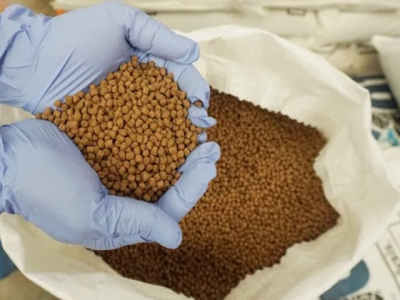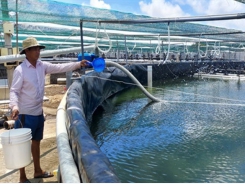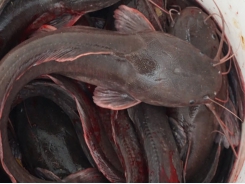Novel feed ramps up tilapia farmers profits

A new low-cost tilapia feed has been developed by researchers in the Philippines, in a bid to help improve tilapia farming efficiency and lower the price of fish at a time of volatile food prices.
Tilapia feeds produced by the Southeast Asian Fisheries Development Center Aquaculture Department (SEAFDEC/AQD) using alternative ingredients to lower production cost and improve the income of farmers. Photo: RH Ledesma
The feed – which contains byproducts of ethanol production, rendered animal protein, and processed copra meal – is the brainchild of a scientist at the Southeast Asian Fisheries Development Center Aquaculture Department (SEAFDEC/AQD). According to a press release from the department, pond trials showed that the new feed performed better than commercially available equivalents.
The feed is also cheaper – costing about P28 per kilogram to produce, while the average cost of a commercial feed is about P34 to 36 per kilogram.
“We came up with this feed formulation to lower the price of feeds, which account for more than 50 to 60 percent of the total production cost in aquaculture,” said Dr Roger Edward Mamauag, head of SEAFDEC/AQD's technology verification and extension division.
Dr Mamauag compared the new formulation with commercial feeds in high-density tilapia pond culture and found it will cost about P1.6 million in commercial feeds to provide for one hectare in a year of operation, but only P1.2 million using the new formula.
The field trials were done in SEAFDEC/AQD’s Dumangas Brackishwater Station (DBS) in Iloilo as part of a collaborative project between SEAFDEC/AQD, the National Fisheries Research and Development Institute (NFRDI), and the Bureau of Fisheries and Aquatic Resources (BFAR).
Dr Mamauag used cheaper and locally available protein ingredients such as distiller’s dried grain soluble, poultry by-product meal, and protein-enhanced copra meal as a substitute to the usual fishmeal, which he says is “an expensive, imported, and unsustainable fish-based ingredient”.
“SEAFDEC/AQD’s goal is to lessen our dependence on fishmeal as a protein ingredient in feeds since it is expensive and unsustainable to harvest fish from the oceans to feed the fish in the farms,” said Dan Baliao, chief of SEAFDEC/AQD.
With the move to veer away from fishmeal dependence, the field trials showed that the new formulation was more efficient than the commercial diet and had a lower feed conversion ratio.
“The tilapia that we fed with our diet gained about 730 percent of its own weight after 90 days, while the tilapia fed with a commercial diet only gained about 680 percent,” said Dr Mamauag.
Baliao also said that the success of this project would also benefit consumers since fish would be available at a lower price.
“We are happy with the outcome of this project, and we are looking forward to the mass production of these cost-effective feeds that would benefit our fish farmers and consumers,” said Dan Baliao, chief of SEAFDEC/AQD.
Dr Jaime Gison, a medical doctor by profession who operates fishponds in Iloilo City and Banate in Iloilo, said that he is happy with the significant result attained in the 90-day culture of tilapia.
“A shorter culture period and cheaper costs of feeds imply more croppings [ie harvests] in a year, hence more profits for the farmer,” added Dr Gison, who is also a former trainee of SEAFDEC/AQD.
“The cost of the feeds that we developed will still go down if produced on a commercial scale. That is why we are doing these field trials to check the effectiveness of the feeds before giving the formulation to private feed manufacturers for adoption,” added Dr Mamauag.
Related news
Tools

Phối trộn thức ăn chăn nuôi

Pha dung dịch thủy canh

Định mức cho tôm ăn

Phối trộn phân bón NPK

Xác định tỷ lệ tôm sống

Chuyển đổi đơn vị phân bón

Xác định công suất sục khí

Chuyển đổi đơn vị tôm

Tính diện tích nhà kính

Tính thể tích ao




 Can aquaculture really take the pressure off capture…
Can aquaculture really take the pressure off capture…  Improving hatchery performance in “Catfish Country”
Improving hatchery performance in “Catfish Country”